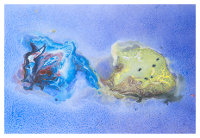Speaker
Andrei Puchkov
(Saint Petersburg State University)
Description
Baryons containing two heavy quarks are treated in the Born-Oppenheimer approximation. Two non-relativistic potential models are proposed, in which the Schrödinger equation admits a separation of variables in prolate and oblate spheroidal coordinates, respectively. In the first model, the potential is equal to the sum of Coulomb potentials of the two heavy quarks, separated from each other by a distance - R and linear potential of confinement. In the second model the center distance parameter R is assumed to be purely imaginary. In this case, the potential is defined by the two-sheeted mapping with singularities being concentrated on a circle rather than at separate points. Thus, in the first model diquark appears as a segment, and in the second - as a circle. In this paper we calculate the mass spectrum of double heavy baryons in both models, and compare it with previous results.
The author (A.P.) acknowledges Saint-Petersburg State University for research grants 11.38.197.2014 and 11.38.66.2012.
Author
Andrei Puchkov
(Saint Petersburg State University)
Co-author
Dr
Alexei Kozhedub
(Saint Petersburg State University)
